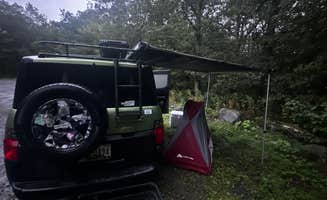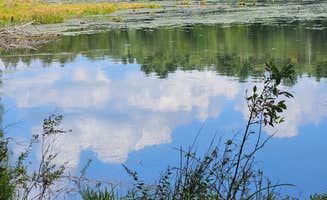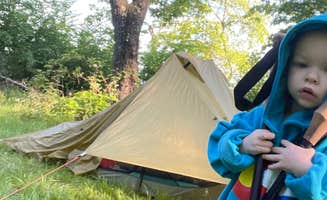Rustic camping near Jessup, Pennsylvania offers various seasonal challenges and terrain considerations. The area features elevations ranging from 850 to 1,200 feet across multiple dispersed camping zones, with autumn temperatures dropping to the low 40s at night. Winter camping often requires additional planning due to limited seasonal maintenance on access roads to primitive sites.
What to do
Trail exploration: Thunder Swamp Trailhead provides numerous day hiking options from the dispersed camping area. A camper noted, "Trailhead parking was chill for a night. No trouble. Tons of hiking. Went down Saw Creek trail to a marsh." The trail system offers moderate terrain suitable for day hikes ranging from 3-7 miles.
Wildlife observation: Observe local fauna in their natural habitat during early morning hours. Spring and summer months provide the best viewing opportunities for deer, turkeys, and various bird species. Keep food secured when away from camp.
Photography opportunities: The changing seasons create distinctive landscape compositions at Hickok Brook dispersed sites. Fall foliage peaks mid-October, with lakeside reflections providing additional compositional elements. One visitor mentioned the sites are "very gorgeous" despite noting the area "is not RV friendly."
What campers like
Privacy between sites: The limited number of camping areas ensures adequate spacing for a quiet experience. As one camper at Hickok Brook described, "There are only 3 spots where we are. No motor vehicles beyond where I'm camping." This creates natural buffers between camping parties.
Natural water features: Streams and small lakes provide both scenery and practical water sources when properly treated. Access varies seasonally with spring offering the most reliable water flow.
Hammock camping options: Many dispersed sites near Jessup feature mature trees ideal for hammock setups. A camper at Appalachian Trail Designated Backpacker Campsite 2 shared their experience: "I was in a hammock and it was a great place for that!" Tree spacing in most areas accommodates various hammock lengths.
What you should know
Limited facilities: Pack in all necessities including water, as most dispersed camping areas provide no amenities. "Bring everything with you. It's a hike back to town... there is a small town 10 minutes away. Eldred, NY," advised one Hickok Brook camper.
Road conditions vary: Many access routes require vehicles with adequate clearance. A visitor to Hickok Brook warned, "The road is very rough with huge potholes so good clearance is a must. It's not a good spot for car camping."
Permit requirements: Some areas require camping permits obtained in advance. According to a camper, "Need a permit on NY state land. Contact Rangers office of whatever county." Check local regulations before arriving as requirements change seasonally.
Water planning: Natural water sources may require significant hiking to access. One camper noted regarding Appalachian Trail Campsite, "No Water (nearest is sunfish pound- easy hike about a 1 round trip)."
Tips for camping with families
Site selection: Choose locations with minimal elevation changes for easier setup with children. Look for natural boundaries like fallen logs or rock formations to define your camping area.
Weather preparation: Temperature swings can be significant in spring and fall. Pack extra layers as evening temperatures often drop 15-20 degrees below daytime highs.
Navigation planning: Cell coverage remains inconsistent throughout primitive camping areas near Jessup. Download offline maps before arrival and bring physical maps as backup, particularly for Russell Brook Road camping areas where trail junctions can be confusing for first-time visitors.
Tips from RVers
Size restrictions: Most dispersed sites cannot accommodate larger rigs. One visitor attempted camping with "a very rugged camper in my full ton diesel pickup" but found the roads impassable for larger vehicles.
Leveling challenges: Bring substantial leveling blocks as most natural sites feature uneven terrain. Small trailers under 16 feet have the best chance at accessing primitive sites, particularly during drier months.
Turnaround limitations: Scout potential sites before committing, as many dead-end forest roads lack adequate turning space for trailers. Backing long distances may be required on narrow access roads.




